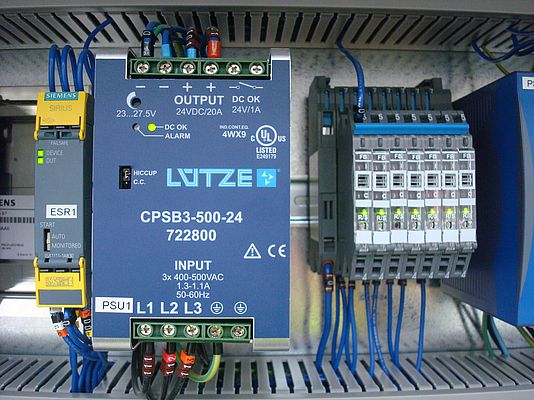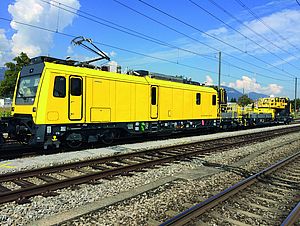Conveyor systems have been a key part of warehousing and logistics operations for decades. Traditionally, the transport systems were controlled by one or several central and additional local switch cabinets; although the wiring for the control, power supply and network comprised cables installed directly into the main control cabinets.
The main control cabinet would host the PLC, power distribution and circuit protection for the DC motors that drive the conveyor rollers. The result was extensive cable runs distributing large DC currents over even longer distances. From today's perspective, it is an outdated way of creating belts for processing packages.
Modern logistics centers now face steadily growing online business and the challenge of supplying an increasing number of products more and more quickly. This means we need more and faster conveyor systems, and that modernizations often need to be contained within the existing infrastructures of logistics centers.
Controlling the conveyors
Typically, parcel conveyor lines use DC motor roller conveyors to move and sort the parcels efficiently. The modern approach to controlling the conveyors is to provide local DC power supplies. The challenge, however, is space. Automation engineers need a way to provide high DC current and install corresponding safety devices close to the DC rollers.
The specially developed new control architecture consists of a main control cabinet that houses the PLC and some controls. Local power distribution, control and circuit protection for the rollers’ DC motors are located in a switchbox below the conveyors. The choice of components for these local control units is critical due to the very limited space available. Each DC motor roller typically needs 2 A at 24 V DC. This means the more rollers that can be controlled locally, the better.
This is dictated by the size of the DC power supply available. Power supplies with 40 A outputs at 24 V DC are common, followed by MCBs (miniature circuit breakers) and/or motor-rated MCBs and contactors to protect and control the DC motor rollers.
Potential problems
However, unfortunately, all these underlying conditions cause potential heat problems. The temperatures within the switchbox rise to more than 60°C which can have a great impact on the service life of the components. A power supply with an efficiency of 90 % or higher can help here. This can also contribute to greatly reducing the loss output within the control panel.
This leads to the next problem: Normally, modern 40 A DC 24 V power supplies are more than 120 mm wide, and older mains adapters are even 270 mm and upwards wide. Accordingly, there are massive space problems in the 600 mm wide control panel.
Power supplies with optimized width as a solution
Newly available power supplies by Lütze, which supply 40 A DC 24 V, now have a width of just 81 mm, which greatly alleviates this situation. A high level of efficiency and streamlined design means that it is possible to maximize the number of DC motor rollers that can be controlled.
The rollers installed in the motors are inductive DC loads which, on start- up, draw large currents. If the maximum current on older supplies was exceeded, they would attempt to protect themselves by going into “crowbar” or “hiccup” mode, causing the supply to shut down. The newly available power supplies by Lütze have “power boost” functions that typically allow them to deliver 50 % extra capacity for a specified time – for example, a 40 A supply can deliver 60 A for 5 seconds. This potentially allows more DC motor rollers to be used, depending on the inrush and continuous currents, cable lengths, and other factors.
Fault current
DC motor rollers are usually protected and controlled by breakers and contactors. The breakers are typically D type rated to cope with the inrush current of the motors and to prevent nuisance tripping. They typically need 10 to 15 times the rated current to protect the circuit. So if a 2 A MCB is fitted, then a minimum fault current of 20 A is required to trip the breaker. At full load, and even with the latest power supplies, the supply may shut down before the breaker trips, which is less than ideal.
In a worst case, an overload could draw an additional fault current of 1 A through the circuit. This could be on the furthest conveyor roller from the control panel if, for instance, a damaged cable creates a high impedance that would go undetected to the MCB and the power supply. The potentially catastrophic consequences are easy to imagine.
The ideal level of protection
To counter these issues, electronic fuses like the Lütze LOCC-Box have been designed to support the new generation of power supplies and to give the correct level of protection. The LOCC-Box covers 12, 24 and 48 V DC systems, with selectable current ranges (typically 1–10 A) and can detect fault currents of 1 mA. Characteristic curves are available that simulate the curves for MCBs to cover different load types – for example, type D for DC motor rollers. The current control system LOCC-Box is also equipped with status outputs and remote maintenance. Some models generate real-time data that can be made available in industrial Industry 4.0 networks and switched remotely.
In total, the interaction of the extremely narrow and highly efficient Lütze power supplies and the intelligent current control LOCC-Box solve all above-mentioned space and heat problems, and also control much more engine rollers per switchbox.




















